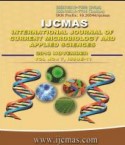


 National Academy of Agricultural Sciences (NAAS)
National Academy of Agricultural Sciences (NAAS)

|
PRINT ISSN : 2319-7692
Online ISSN : 2319-7706 Issues : 12 per year Publisher : Excellent Publishers Email : editorijcmas@gmail.com / submit@ijcmas.com Editor-in-chief: Dr.M.Prakash Index Copernicus ICV 2018: 95.39 NAAS RATING 2020: 5.38 |
Extensive coal mining activities in Jaintia Hills of Meghalaya, has turned large areas into degraded land, creating unfavourable condition for plant growth due to heavy metal pollution. Owing mostly to existing acidity-related fertility stress, average crop productivity in acid soil regions like Meghalaya is very low, coupled with increasing concentration of heavy metals, productivity has dropped further. Therefore decontamination of these heavy metal polluted soils is very important. Phytoremediation is an aspect of bioremediation that uses plants for the treatment of polluted soils. Therefore, a pot culture experiment was conducted using heavy metal polluted coal mined soil of Jaintia Hills in order to assess the phytoremediation effect of the two crops viz. sunflower and asparagus. From the pot culture experiment, it is observed that the Sunflower was superior phytoremediating crop in comparison to Asparagus. The analysis of heavy metals in the soil after harvesting of phytoremediating crops indicated that the heavy metals content (mg kg-1) reduced significantly in both the soils phytoremediated by Sunflower and Asparagus compared with non-phytoremediated soil. However, the soil phytoremediated by Sunflower recorded least heavy metals content indicating its superiority over Asparagus.
 |
 |
 |
 |
 |